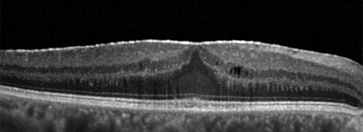Epiretinal Membrane

What is Epiretinal Membrane?
An epiretinal membrane is characterized by a thin layer of tissue on the front surface of the macula which is the region responsible for central and color vision.
Who is at risk for Epiretinal Membrane?
Approximately 5% of healthy individuals between the ages of 50 and 70 are at risk of developing an unexplained epiretinal membrane.
What is the cause of Epiretinal Membrane?
Most epiretinal membranes occur in an otherwise healthy eye, however, apparently develop due to posterior vitreous separation. Epiretinal membranes may occur in conjunction with other eye problems such as retinal detachment, problems with retinal blood vessels, or eye injury. Freezing treatment (cryo) or laser treatment used to treat retinal tears and breaks may contribute to the formation of epiretinal membranes. Approximately 2-3% of otherwise successful retinal detachment surgeries are followed by the development of epiretinal membranes. Inflammatory eye diseases can cause epiretinal membranes, too.
What are the symptoms of Epiretinal Membrane?
Distortion of central vision is the main symptom of epiretinal membrane. Patients typically complain of the presence of something that prevents seeing the central. After the reduction of visual acuity, the most frequent complaints occur during reading of written texts or while looking at objects. Patients may describe straight lines look like wavy or distorted (metamorphopsia). Objects may appear larger (macropsia) or smaller (micropsia) than they are. Most patients develop membranes in one eye only.
Does Epiretinal Membrane cause permanent visual loss?
As the epiretinal membrane contracts, it causes the retina to become distorted or wrinkled thereby disturbing the patient's vision. Epiretinal membranes can damage the retina so severely that the patient can almost lose central vision and only see with their peripheral vision. They progress over many months or even years and gradually worsen vision over this time.
How is Epiretinal Membrane diagnosed?
For the diagnosis of Epiretinal membrane, a routine eye examination is followed by posterior segment examination with pupil dilatation. Optical coherence tomography (OCT), using light waves to visualize the retina without any side effects, is performed in patients suspected of epiretinal membrane.
What is Epiretinal Membrane Treatment?
The only treatment of epiretinal membrane is surgery to remove the membrane. If symptoms are mild, surgery is usually not necessary. But if symptoms are significant, then an operation called a vitrectomy is performed to remove the membrane. The majority of patients’ vision improved following the operation. But since the retina is nerve tissue, it requires months to fully regain its function.
Last Updated: October 23, 2024



























